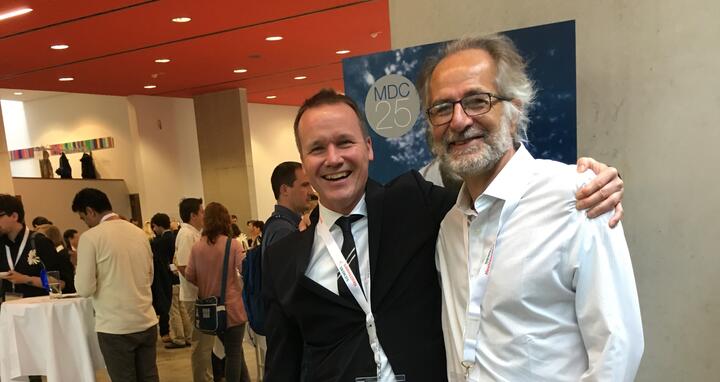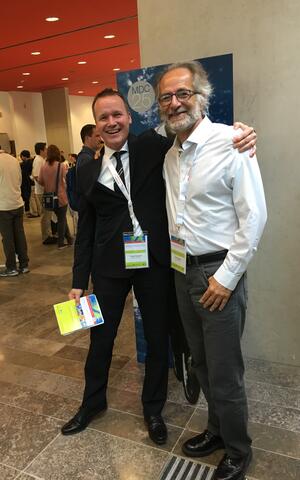A meeting point in the mesosphere: A report from the 8th UHF MR Symposium
A new generation of ultrahigh field MRI instruments is zooming in on a scale of life that is crucial to biomedical progress. Along the way, the technology is attracting highly talented young scientists to the intersection between physics, biology, and medicine ... A report from the 8th Conference on UHF MRI at the MDC, held in June.
Many scales of life lie outside the range that can be visualized by today's biomedical researchers. Experts in magnetic resonance imaging use the term mesosphere to refer to a "resolution gap" between the scale of cells and that of tissues and organs. Crucial disease processes occur within this zone, and our inability to watch them makes it hard to connect the activity of cellular molecules to their effects on the body as a whole and translating discoveries from the laboratory into clinical applications.
The mesosphere was a central theme at the eighth annual scientific symposium held on the Buch campus and devoted to Ultrahigh Field MRI (UHF MRI). This year the subtitle was "Clinical Needs, Research Promises and Technical Solutions." MRI has long been an essential diagnostic tool in clinics; as it zooms in on the mesosphere, it is finding many more uses in research – and as a bridging technology. Those developments can be traced to a new generation of extremely powerful magnets, custom-designed arrays of radiofrequency coils, and lots of other innovations. Using this technology, resolution is measured in units called voxels: akin to the pixels of a camera or a flatscreen TV, but in three dimensions. Smaller voxels represent higher resolution, and shrinking them is a major aim of UHF MRI.
A keynote speaker with an integrative theme
So it's little surprise to encounter voxels in the keynote address by Kamil Ugurbil, an expert in MRI from the University of Minnesota. He's a congenial speaker with an inclusive message that sets the tone for the entire meeting. "A tremendous amount stands to be gained if we can sharpen the resolution of our voxels by an order of magnitude," Ugurbil says. To illustrate the point he discusses the BRAIN initiative in the United States, whose ultimate goal is to describe the functions of the brain by linking all of its scales. This means bridging the gap between the "fundamental units" of brain function – synapses – to the vast connectome of nerves. The goal is to map local and overarching networks in which nerves are linked, the routes along which they connect large-scale regions of the brain, and changes in functional connectivity that occur during highly complex behavior.
"The typical scanner found in clinics and many research institutes today produces a magnetic field strength of 3 Tesla," he says. "With these instruments a single voxel is so large that it contains hundreds of thousands of nerves. With our much more powerful 7 Tesla machines, advanced machines like the human scanner here on your campus, we can get the voxel down to 0.5 microliters. If we can go farther – down to 0.1 microliters – we still haven't reached the resolution of single cells. But at that point we will be watching a few thousand nerves, which is the level of neural ensembles that perform functional computation in the brain."
Imaging at the level of a tenth of a microliter, Ugurbil says, would allow scientists to image structures such as the lamina and columns formed by the nerves that make up the human auditory system. During the rest of the talk he outlines steps necessary to achieve this goal. The effort will not only require larger magnets, of fantastic sizes able to produce magnetic fields at strengths of 10.5 Tesla and above, but many more technological innovations: new arrays of radiofrequency coils, which tune the fields to produce images; new methods of reducing noisy backgrounds in the images which are obtained; and a faster acquisition and analysis of the data produced during the scanning process. Speed will permit more, finer real-time observations of living processes – giving an unprecedented look at both the healthy and pathological functions of organs. Another giant step forward in the field is the ability to observe atoms other than hydrogen, which is the basis for most of today's MR imaging. That would open new dimensions of the fundamental biology of tissues and organs to direct, non-invasive investigations.
"Combining all of these factors should produce the gain in an order of magnitude which we are hoping for," Ugurbil says. "And it should be possible at the field strengths of magnets which are already being produced and brought on line, at 20 Tesla and beyond."
A new view of organs and processes
UHF MR permits the technology to be applied to a range of new substances including sodium and fluorine, which play crucial roles in disease processes in a number of organs and tissues. Sodium imaging is giving scientists a new look at structures in the eye and sharper images of the tumors that affect the optic nerve, for example. This is of enormous help in planning surgeries to correct the problem – and in checking on the effectiveness of therapies. Katharina Paul from the Niendorf group reported on some of the team's efforts to free eye imaging from problems of noise and geometric distortions.
The takeup and release of sodium is also fundamental to heart functions, and high-resolution images of the substance have produced amazingly detailed views of the beating heart in living animals. Such images are crucial in studying structural defects of the heart and disruptions of blood flow that occur in a number of cardiovascular diseases. Julie Magat, of the University of Bordeaux, reported that the efforts promise to reveal links between structural and electrical data that could reveal connections between arrhythmia and structural changes in the myocardium. "These data can also be used to create an atlas of images of heart diseases and will be incorperated into computer simulations for better modeling of electrical propagation in the heart," she says.
Sonia Waiczies from the Niendorf group reported on the team's work to make fluorine MRI a possibility; this would have implications in the "theranostics" of arthritis. In an animal model of rheumatoid arthritis, the scientists inject PFC nanoparticles bearing fluorine into joints, where they are taken up by immune cells and permit tracking the progress of inflammations. An advantage is that there are no intrinsic signals from fluorine in the body; the challenge is that the signals from the substance are of very low strength and require the use of very strong magnetic fields. In the fall, she has received a grant to travel to Tallahassee, Florida, to conduct studies on the first 21 Tesla animal scanners; the national facility there encourages international collaborations and is giving her free time to work on the fluorine project.
And Teresa Serradas Duarte, a PhD student from Portugal who had completed her Master's thesis in the Niendorf group. She returned home to do her doctoral work at the Champalimaud Center for the Unknown in Lisbon, which hosts a 16.4 Tesla MR machine. She is using it to peer into the brain and spine, in hopes of glimpsing critical functions that occur at the level of the mesosphere. Niendorf is proud that she's back - and especially proud that she's a speaker on the program.
"That's a great accomplishment for a first-year PhD student," he says. "Some people will remember her from our 2015 meeting, when she was a master's student, and presented her work in one of the 'power poster' sessions." As well as being one of the most popular activities in the symposium, he says, the sessions give scientists a great chance to practice an important skill – summarizing their work in a very short time. "The result is that more participants visit the posters for longer discussions."
New coils, new questions
The speakers on the program included several other members of Niendorf's group at the Berlin Ultrahigh Field Facility (BUFF) here on the MDC campus. Henning Reimann gave a talk entitled, "How much pain is in BOLD MR?" His current work is based on an observation that the signal by which scientists often assign functions to regions of the brain does not directly reflect neuronal activity, but rather levels of oxygenation in the blood. While a connection between the two is usually assumed – active neurons require more energy, and thus an increase in blood flow – many of the effects seen in functional MRI can be accounted for by the brain's inability to completely maintain a steady blood pressure in all of its regions. When an animal experiences salient stimuli, such as pain, it experiences a sudden increase in blood pressure that alters levels of oxygenated blood in certain regions. These almost entirely overlap with regions that scientists have called the "pain matrix" – which Reimann thinks may be better characterized as a map of regions that are most strongly affected by blood pressure that occurs as an immediate response to salient stimuli.
PhD student Eva Oberacker, also of Niendorf's team, talked about the group's efforts to take advantage of the thermal dimension of MR to explore a dimension of life that has been hard to manipulate – temperature. Under the Advanced ERC grant recently obtained by Niendorf, the lab will begin using high magnetic fields of the instruments to manipulate the temperature of tissues within living organisms in a very focused way. The aim is to understand how processes within diseased and healthy tissues respond to heating, in hopes of opening up this dimension for diagnostic and therapeutic purposes.
The theme was taken up in another of the "power poster" sessions, by team member Yiyi Ji, who is working with thermoresponsive polymers. Drugs or other substances can be attached to artificial probes that are inserted into the body, where they remain inert until heated in the magnetic field and radio frequencies of the MR machine. At that point, they can be released in precise stages – another potential new therapeutic device.
And not to forget...
"One thing that has made this symposium a very successful event for many years is its completely open format," Niendorf says. "There's no entry fee, which has been important in attracting people from the wide range of fields that are playing a role in advancing the clinical and research applicability of MRI. One thing that has made this possible has been the consistent support we receive from the DFG – they have been extremely supportive. While obtaining DFG funding for such events is sometimes difficult, they are supporting not only this symposium, but another the second symposium on renal MRI that we will hold in the fall."
Part of the DFG's interest, he says, lies in the fact that the symposium is part of a series, and also that it attracts scientists beyond the group that normally attends such meetings. "Normally when I go to a big meeting I often know 80 percent of the attendees," he says. "For this symposium I typically know 10 to 20 percent, and the rest represent a big community of newbies from diverse fields. And the speakers have really made an effort in the way we have shaped their topics. From the excellent overview given by Kamil Ugurbil in the keynote speech to the talk on MR safety, everything has been very practical and future-oriented."








